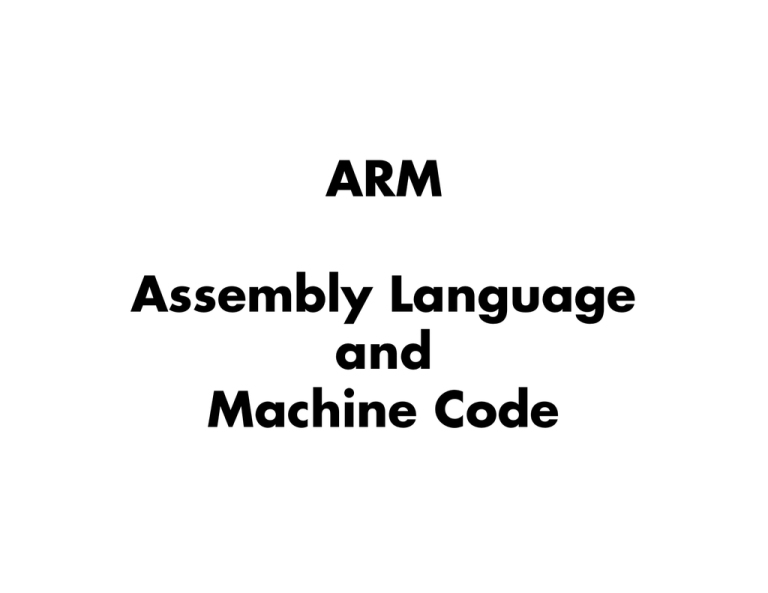Slides - CS107e
advertisement

ARM Assembly Language and Machine Code Concepts Types of ALU instructions Bits and bit operations Condition codes Branches Addressing modes in loads & stores //ProgramtoturnonanLED #defineFSEL20x20200008 ldrr0,=FSEL2 movr1,#1;GPI020Output strr1,[r0] #defineSET00x2020001C ldrr0,=SET0 movr1,#(1<<20);Bit20 strr1,[r0] loop:bloop 3 Types of Instructions 1. Data processing instructions 2. Loads from and stores to memory 3. Branches to new program locations Data Processing Instructions From armisa.pdf #dataprocessinginstruction #ra=rbop#imm ##imm=uuuuuuuu oprbraimm 1110001oooo0bbbbaaaa0000uuuuuuuu addr0,r1,#1 Assembly AND EOR(XOR) SUB RSB ADD ADC SBC RSC TST TEQ CMP CMN ORR(OR) MOV BIC MVN Code 0000 0001 0010 0011 0100 0101 0110 0111 1000 1001 1010 1011 1100 1101 1110 1111 Operations ra=rb&rc ra=rb^rc ra=rb-rc ra=rc-rb ra=rb+rc ra=rb+rc+CARRY ra=rb-rc+(1-CARRY) ra=rc-rb+(1-CARRY) rb&rc(ranotset) rb^rc(ranotset) rb-rc(ranotset) rb+rc(ranotset) ra=rb|rc ra=rc ra=rb&~rc ra=~rc #dataprocessinginstruction #ra=rbop#imm ##imm=uuuuuuuu oprbraimm 1110001oooo0bbbbaaaa0000uuuuuuuu addr0,r1,#1 addr1r0#1 11100010100000010000000000000001 #dataprocessinginstruction #ra=rbop#imm ##imm=uuuuuuuu oprbraimm 1110001oooo0bbbbaaaa0000uuuuuuuu addr0,r1,#1 addr1r0#1 11100010100000010000000000000001 11100010100000000001000000000001 E2810001 ADDR+3 ADDR+2 ADDR+1 ADDR E2 81 00 E2 81 00 01 01 little-endian (lowestbytefirst) 01 00 81 E2 big-endian (highestbytefirst) The 'little-endian' and 'big-endian' terminology which is used to denote the two approaches [to addressing memory] is derived from Swift's Gulliver s Travels. The inhabitants of Lilliput, who are well known for being rather small, are, in addition, constrained by law to break their eggs only at the little end. When this law is imposed, those of their fellow citizens who prefer to break their eggs at the big end take exception to the new rule and civil war breaks out. The big-endians eventually take refuge on a nearby island, which is the kingdom of Blefuscu. The civil war results in many casualties. Read: Holy Wars and a Plea For Peace, D. Cohen Memory INST Registers + DATA Shift ALU ADDR Rotate Right (ROR) #dataprocessinginstruction #ra=rbopimm #imm=(uuuuuuuu)ROR(2*iiii) oprbrarorimm 1110001oooo0bbbbaaaaiiiiuuuuuuuu #dataprocessinginstruction #ra=rbopimm #imm=(uuuuuuuu)ROR(2*iiii) oprbrarorimm 1110001oooo0bbbbaaaaiiiiuuuuuuuu addr0,r1,#0x10000 addr1r00x01>>>2*8 11100010100000010000100000000001 #dataprocessinginstruction #ra=rbopimm #imm=(uuuuuuuu)ROR(2*iiii) oprbrarorimm 1110001oooo0bbbbaaaaiiiiuuuuuuuu addr0,r1,#0x10000 addr1r00x01>>>2*8 11100010100000010000100000000001 11100010100000010000100000000001 E2810801 #Determinethemachinecodefor subr7,r5,#0x300 #imm=(uuuuuuuu)ROR(2*iiii) #Rememberthatraistheresult oprbrarorimm 1110001oooo0bbbbaaaaiiiiuuuuuuuu //Whatisthemachinecode? #dataprocessinginstruction #ra=rbopimm #imm=uuuuuuuuROR(2*iiii) oprbraror 1110001oooo0bbbbaaaaiiiiuuuuuuuu subr7,r5,#0x300 subr5r7#0x03>>>24 11100010010001010111110000000011 11100010010001010111110000000011 E2457C03 Bit Manipulations //Mayreplace #defineFSEL20x20200008 ldrr0,=FSEL2 //with movr0,#0x20000000//#(0x20>>>8) orrr0,#0x00200000//#(0x20>>>16) orrr0,#0x00000008 31 30 29 28 27 26 25 24 23 22 21 20 19 18 17 16 15 14 13 12 11 10 9 GPIO 29 GPIO 28 GPIO 27 GPIO 26 GPIO2 5 GPIO 24 GPIO2 3 8 7 6 5 4 3 2 1 0 GPIO 22 GPIO2 1 //FSEL2intor0 movr0,#0x20000000//#(0x20>>>8) orrr0,#0x00200000//#(0x20>>>16) orrr0,#0x00000008 //SetGPIO20toOUTPUT movr1,#1 strr1,[r0] //AlsosetGPIO21toOUTPUT //How? GPIO2 0 31 30 29 28 27 26 25 24 23 22 21 20 19 18 17 16 15 14 13 12 11 10 9 GPIO 29 GPIO 28 GPIO 27 GPIO 26 GPIO2 5 GPIO 24 GPIO2 3 8 7 6 5 4 3 2 1 0 GPIO 22 GPIO2 1 //FSEL2intor0 movr0,#0x20000000//#(0x20>>>8) orrr0,#0x00200000//#(0x20>>>16) orrr0,#0x00000008 //SetGPIO20and21bothtoOUTPUT movr1,#1 orrr1,#(1<<3) strr1,[r0] GPIO2 0 31 30 29 28 27 26 25 24 23 22 21 20 19 18 17 16 15 14 13 12 11 10 9 GPIO 29 GPIO 28 GPIO 27 GPIO 26 GPIO2 5 GPIO 24 GPIO2 3 8 7 6 5 4 3 2 1 0 GPIO 22 GPIO2 1 //FSEL2intor0 movr0,#0x20000000//#(0x20>>>8) orrr0,#0x00200000//#(0x20>>>16) orrr0,#0x00000008 //SetGPIO20toOUTPUT movr1,#1 … //SetGPIO21toOUTPUT ldrr1,[r0] bicr1,#(0x7<<3) orrr1,#(0x1<<3) strr1,[r0] GPIO2 0 Condition Codes //loop #defineDELAY0x3F0000 movr2,#DELAY loop: subsr2,r2,#1//setcondcode bneloop Condition Codes Z - Result is 0 N - Result is <0 C - Carry generated V - Arithmetic overflow Carry and overflow will be covered later #dataprocessinginstruction #ra=rbop#imm ##imm=uuuuuuuuROR(2*iiii) # #s—setconditioncode # oprbra 1110001oooosbbbbaaaaiiiiuuuuuuuu #dataprocessinginstruction #ra=rbopimm #imm=uuuuuuuuROR(2*iiii) #s=1meanssetconditioncode opsrbra 1110001oooosbbbbaaaaiiiiuuuuuuuu subsr2,r2,#1 subsr2r201 11100010010100100010000000000001 E2522001 Branch Instructions #branch condaddr cccc101Loooooooooooooooooooooooo b=bal=branchalways condaddr 1110101Loooooooooooooooooooooooo bne condaddr 0001101Loooooooooooooooooooooooo Condition Codes Z - the result is 0 N - the result is negative C - a carry was generated V - an arithmetic overflow occurred Blink //ConfigureGPIO20forOUTPUT loop: //TurnonLED //delay //TurnoffLED //delay bloop //ProgramtoturnonanLED //SetupGPIO20 #defineFSEL20x20200008 ldrr0,=FSEL2 movr1,#1 strr1,[r0] //Bit20forGPIO20 movr1,#(1<<20) … //r0pointstoGPIOSET0register #defineSET00x2020001C ldrr0,=SET0 strr1,[r0] //delay #defineDELAY0x3F0000 movr2,#DELAY wait1: subsr2,#1 bnewait1 … //r0pointstoGPIOCLR0register #defineCLR00x20200028 ldrr0,=CLR0 strr1,[r0] //delay movr2,#DELAY wait2: subsr2,#1 bnewait2 //GPIOregistersdon'tactlikememory //r0pointstoGPIOSET0register ldrr0,=SET0 strr1,[r0] //r0pointstoGPIOCLR0register ldrr0,=CLR0 strr1,[r0] Orthogonal Instructions Any operation Register vs. immediate operands All registers the same** Predicated/conditional execution Set or not set condition code Orthogonality leads to composability Summary You need to understand how processors represent and execute instructions Instruction set architecture often easier to understand by looking at the bits Reading assembly allows you to know what the processor is doing Rarely write assembly, Normally write code in C (next week) The Fun Begins … Labs!! ■ Assembly Raspberry Pi Kit ■ Lab assignments sent out before class ■ Read lab1 guide (now online) ■ Install tool chain ■ Bring $50 lab fee Assignment 1 ■ Larson scanner Extra Slides Branch Instructions and Pipelining Processors execute instructions in phases Fetch Decode Execute Phases are pipelined Fetch Decode Execute Fetch Decode Execute Fetch Decode Execute PC value is 2 instructions ahead (PC+8) of the executing instruction (PC+8) //disassembleon.s 0: e59f0014 ldr r0,[pc,#0x14] 4: e3a01001 mov r1,#1 8: e5801000 str r1,[r0] c: e59f000c ldr r0,[pc,#0x0c] 10: e3a01601 mov r1,#0x100000 14: e5801000 str r1,[r0] 18: eafffffe b18//[pc,-2*4] 1c: 20200008 20: 2020001c Indexed Loads PC Relative Addressing r0=mem[r1] Memory GenerateADDR INST Registers + DATA r1 ALU ldrr0,[r1] ADDR r0=mem[r1+imm] Memory GenerateADDR Registers INST imm + DATA r1 ALU ldrr0,[r1,imm] ADDR r0= mem[r1+imm] Memory LoadDATA INST Registers + DATA ALU r0 ldrr0,[r1,imm] ADDR //disassembleon.s //PCrelativeaddressing 0: e59f0014 ldr r0,[pc,#0x14] 4: e3a01001 mov r1,#1 8: e5801000 str r1,[r0] c: e59f000c ldr r0,[pc,#0x0c] 10: e3a01601 mov r1,#0x100000 14: e5801000 str r1,[r0] 18: eafffffe b18//[pc,-2*4] 1c: 20200008 20: 2020001c //disassembleon.s //PCrelativeaddressing 0: e59f0014 ldr r0,[pc,#0x14] 4: e3a01001 mov r1,#1 8: e5801000 str r1,[r0] c: e59f000c ldr r0,[pc,#0x0c] 10: e3a01601 mov r1,#0x100000 14: e5801000 str r1,[r0] 18: eafffffe b18//[pc,-2*4] 1c: 20200008 20: 2020001c


